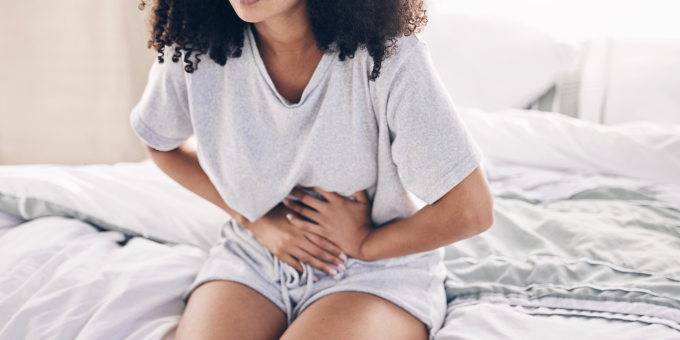With Endometriosis Awareness Month upon us, there couldn’t be a better time for a technological advancement to drop – in Australia alone, up to one in seven women grapple with the relentless pain of endometriosis, a chronic disease that has seen no new medication approval for over a decade, in spite of the soaring rates of women afflicted. That’s why the arrival of a ground-breaking oral medication has sent ripples through the community – but there’s a catch.
In light of the chronic pain hundreds of thousands of Aussie women experience from endometriosis, a beacon of hope has emerged in the form of a new treatment offering respite. Enter Ryeqo, a ground-breaking oral medication comprising a trio of key ingredients – relugolix, estradiol, and norethisterone acetate – Ryeqo acts by suppressing primary estrogen production, preserving bone health, and safeguarding the uterine lining. But does it actually work? Well the woman spearheading this medical breakthrough, gynaecologist and pain specialist Professor Thierry Vancaillie, tells 9 News she’s confident in the treatment, highlighting the significance of Ryeqo's oral formulation, a departure from previous options that have been less than appealing, to put it lightly.
"Medical management usually involves reducing the oestrogen circulation so the endometriosis is not stimulated to grow," Professor Thierry Vancaillie told the publication. "So far we've only had injections or nasal sprays and this is the first oral form."

Against the backdrop of an average six-year wait for diagnosis and the haunting absence of a cure or known cause, Ryeqo emerges as a potential breakthrough after years of stagnancy, despite the soaring rates of endometriosis.
But here's the million-dollar question: can you afford to experience the life-changing benefits of Ryeqo? Let’s find out.
So, What’s the Catch?
You’re probably wondering about the price tag attached to this revolutionary treatment – unfortunately, it’s yet to be subsidised by the government. Translation? Sky-high costs. Instead of patients paying the Pharmaceutical Benefits Scheme price of $31.60, they’ll have to fork out around $135 a month. Considering that endometriosis is a chronic disease, this will have patients paying a whopping $1620 a year. But hope isn’t lost – recognising the urgent need for accessible treatment options, efforts are underway to address the accessibility gap surrounding Ryeqo, with a submission having been made to the Pharmaceutical Benefits Advisory Committee to subsidise the cost of Ryeqo, ensuring that relief is within reach for all who need it. Endometriosis Australia CEO Maree Davenport underscores the importance of equity within the medical system, emphasising that affordability should never be a barrier to essential care. No argument from us!
"We know that 70 per cent of all endo sufferers take time off work unpaid," Endometriosis Australia CEO Maree Davenport told 9 Now. "It needs to be at a price point where it's affordable and that's where we have the equity in the medical system."
The reality is that endometriosis doesn't discriminate based on income – it affects women from all walks of life, regardless of their socioeconomic status. Yet, for those without the means to afford expensive medications like Ryeqo, the prospect of finding relief can feel like an insurmountable barrier. For some, it's a choice between paying for essential medication and putting food on the table or paying the bills. This stark reality underscores the urgent need for accessible treatment options that don't place an undue financial burden on patients already struggling to make ends meet. By advocating for subsidisation and pushing for equitable access to Ryeqo, we can ensure that endometriosis sufferers – regardless of their financial circumstances – have the opportunity to benefit from this ground-breaking treatment. Together, we can break down barriers and pave the way for a future where no woman has to suffer in silence due to lack of access to essential medication.
Now that's not to say this medication is the answer - while it may be a promising and less invasive mode of treating the chronic disease, effects will vary from person-to-person. It's also worth noting that the side effects can be relatively common, affecting 1 in 10 at varying degrees of severity. The most common are headaches, hot flushes and bleeding from the womb. It is advised that the drug is avoided in women who have had blood clots in the veins or a stroke or a heart attack.
What is Endometriosis?

Endometriosis is a chronic condition involving the growth of cells similar to those found in the uterus’ lining in other areas of the pelvis – this can include the bowel, bladder and ovaries – and even elsewhere in the body. Not-so-fun-fact – this tissue has even been found in the brain. Let that sink in. There’s nowhere this tissue can’t reach, and yet, we’ve seen little development in the way we treat this debilitating condition. Though the cause of the condition hasn’t been pinned down yet, there are a number of contributing factors associated with endometriosis. Those who have a family history of the disorder are particularly at risk, with research clocking that increased risk in at around 10 times higher than the rest of the population. Take a look at the most common contributing factors.
- Genetics
- Being a twin
- Having a history of heavy periods
- Having a history of periods that last longer than five days
- Having the first period before the age of 11
- Low body fat
- Alcoholism
Abdominal pain is one of the most common symptoms of endometriosis – it may be dull or sharp, and for some it feels like severe period cramps and is known to worsen with time. Pelvic pain, leg pain and painful bowel movements are also common symptoms, and despite how severe they may be, it can take between 4 and 11 years for people to receive their diagnosis, with up to 6 in 10 cases left undiagnosed.
Delayed diagnoses, medical gaslighting and dismissal are all too common for women dealing with endometriosis – and, really, any condition. Read about Bindi Irwin’s shocking endometriosis story, along with IQS’s own Clara Mearns’ experience with the condition and her battle to get diagnosed.
Head on over to Endometriosis Australia for more information on the condition and how to support its research and treatment.
Keen to take your health back into your own hands? What you put on your plate plays a major role in your wellbeing, and we’ve put in the hard yards so you can enjoy the benefits of an extensive, wholistic program that covers everything from learning how to manage nutrition and mental health to social situations. Plus, we’re dropping our ALL NEW APPwith streamlined featured, 2500 recipes, 1:1 coaching and exclusive exercise courses to help you combat the cravings. When you join us for the 8-Week Program you’ll have exclusive access to expert guidance, nutritional planning and support every step of the way. Take a peek at what’s on offer:
- 8 weeks of meal plans and shopping lists.
- A range of 2500 exclusive recipes, including sugar-free desserts, snacks and all the old favourites.
- Community forums to share and discuss your experience.
- Expert support to guide you through each week – from world-renowned chef Sarah Glover to yoga teachers, nutritionists and naturopaths.
- 1:1 dedicated coaching.

Join us for the next round – don’t wait, JOIN NOW!






Leave a comment (all fields required)